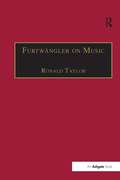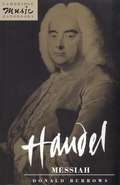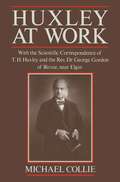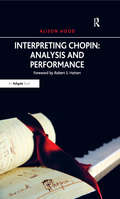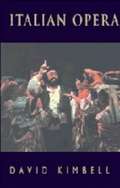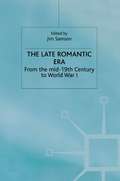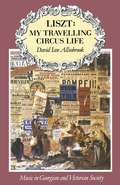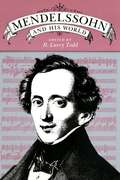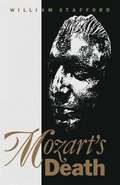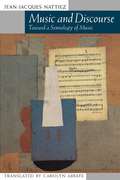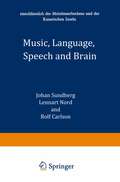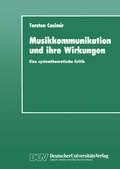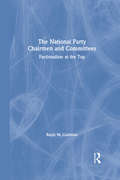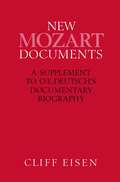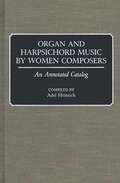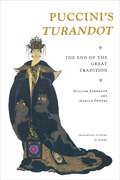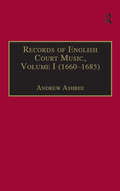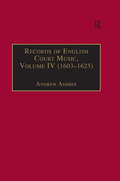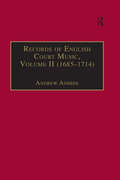- Table View
- List View
Furtwänler on Music: Essays and Addresses by Wilhelm Furtwänler
by Ronald TaylorWilhelm Furtw ler left not only some of the greatest interpretations of operatic and symphonic music on record, but also expressed his views on musical issues of the moment in a number of outspoken essays and talks. His writings range from practical matters of performance and interpretation to aesthetic reflections on what he saw as the alarming direction in which music was developing in the wake of Schoenberg and the twelve-tone system of composition. Professor Ronald Taylor has here, for the first time, translated and annotated a selection of Furtw ler's writings covering the four decades from the First World War to the conductor's death in 1954, and prefaced them with an essay on Furtw ler's controversial career and complicated personality. The result is a collection of stimulating pieces with a claim on our attention, made all the greater for reflecting the musical and philosophical ideals of one of the great conductors of the twentieth century.
Furtwänler on Music: Essays and Addresses by Wilhelm Furtwänler
by Ronald TaylorWilhelm Furtw ler left not only some of the greatest interpretations of operatic and symphonic music on record, but also expressed his views on musical issues of the moment in a number of outspoken essays and talks. His writings range from practical matters of performance and interpretation to aesthetic reflections on what he saw as the alarming direction in which music was developing in the wake of Schoenberg and the twelve-tone system of composition. Professor Ronald Taylor has here, for the first time, translated and annotated a selection of Furtw ler's writings covering the four decades from the First World War to the conductor's death in 1954, and prefaced them with an essay on Furtw ler's controversial career and complicated personality. The result is a collection of stimulating pieces with a claim on our attention, made all the greater for reflecting the musical and philosophical ideals of one of the great conductors of the twentieth century.
Handel: Messiah (Cambridge Music Handbooks) (PDF)
by Donald Burrows Julian RushtonThis new guide to Handel's most celebrated work traces the course of Messiah from Handel's initial musical response to the libretto, through the oratorio's turbulent first years to its eventual popularity with the Foundling Hospital performances. Different chapters consider the varying reception the work received in Dublin and London, the uneasy relationship between the composer and his librettist Charles Jennens and the many changes Messiah underwent through the varying needs and capacities of Handel's performers. As well as tracing the history of the work's development, the book addresses musical and technical issues such as Messiah's place in the oratorio genre, Handel's treatment of structural design, tonal relationships and English word-setting. An edited libretto elucidates the variants between the text that Handel set and the texts of the early printed word-books. Donald Burrows brings many new insights to this fascinating account of one of the favourite works of the concert hall.
Huxley at Work: With the Scientific Correspondence of T. H. Huxley and the Rev. Dr George Gordon of Birnie, near Elgin
by Michael CollieThe previously unpublished correspondence of T.H.Huxley with Rev. George Gordon is an important new addition to the literature on Huxley and Victorian science. The correspondence is self-contained and wholely scientific, concerning the unexpected discovery of reptilian fossils and footprints near Elgin, and relates to a most important aspect of Huxley's career: defining the relationship between geology and palaentology. The letters are complemented by an incisive analysis of Huxley's work as a palaentologist and the development of his views on evolution.
Interpreting Chopin: Analysis And Performance
by Alison HoodMusic theory is often seen as independent from - even antithetical to - performance. While music theory is an intellectual enterprise, performance requires an intuitive response to the music. But this binary opposition is a false one, which serves neither the theorist nor the performer. In Interpreting Chopin Alison Hood brings her experience as a performer to bear on contemporary analytical models. She combines significant aspects of current analytical approaches and applies that unique synthetic method to selected works by Chopin, casting new light on the composer’s preludes, nocturnes and barcarolle. An extension of Schenkerian analysis, the specific combination of five aspects distinguishes Hood’s method from previous analytical approaches. These five methods are: attention to the rhythms created by pitch events on all structural levels; a detailed accounting of the musical surface; 'strict use' of analytical notation, following guidelines offered by Steve Larson; a continual concern with what have been called 'strategies' or 'premises'; and an exploration of how recorded performances might be viewed in terms of analytical decisions, or might even shape those decisions. Building on the work of such authors as William Rothstein, Carl Schachter and John Rink, Hood’s approach to Chopin’s oeuvre raises interpretive questions of central interest to performers.
Interpreting Chopin: Analysis and Performance
by Alison HoodMusic theory is often seen as independent from - even antithetical to - performance. While music theory is an intellectual enterprise, performance requires an intuitive response to the music. But this binary opposition is a false one, which serves neither the theorist nor the performer. In Interpreting Chopin Alison Hood brings her experience as a performer to bear on contemporary analytical models. She combines significant aspects of current analytical approaches and applies that unique synthetic method to selected works by Chopin, casting new light on the composer’s preludes, nocturnes and barcarolle. An extension of Schenkerian analysis, the specific combination of five aspects distinguishes Hood’s method from previous analytical approaches. These five methods are: attention to the rhythms created by pitch events on all structural levels; a detailed accounting of the musical surface; 'strict use' of analytical notation, following guidelines offered by Steve Larson; a continual concern with what have been called 'strategies' or 'premises'; and an exploration of how recorded performances might be viewed in terms of analytical decisions, or might even shape those decisions. Building on the work of such authors as William Rothstein, Carl Schachter and John Rink, Hood’s approach to Chopin’s oeuvre raises interpretive questions of central interest to performers.
Italian Opera (PDF)
by David KimbellItaly was the birthplace of opera. In this authoritative and accessible account of Italian opera, David Kimbell introduces the composers and dramatists, the singers and audiences who, over three hundred years, have created not only a national tradition but the central tradition from which others have drawn their inspiration. He traces the history of Italian opera from its origins in the humanism of the Renaissance to Puccini in the early twentieth century, drawing attention not only to musical issues but also to the social, literary, and philosophical ideas that have shaped modern Italian civilisation. Each part is illustrated by a detailed critical discussion of a key work.
The Late Romantic Era: Volume 7: From the Mid-19th Century to World War I (Man & Music)
by Jim SamsonThe Late Romantic Era treats the period bounded by the 1848 revolutions and the outbreak of World War I. It examines several musical dimensions of the bourgeois cultural ascendancy of the second half of the 19th century - the growth of independent institutions of music-making, the consolidation of a standard classical repertory and the emergence of increasingly specific repertories of popular music, professional and amateur. Single chapters on particular countries or regions are framed by pairs of chapters on Vienna, Paris and the German cities. In an opening chapter Dr Samson places the later geographical surveys within a thematic context which embraces social and economic change, political ideology and the climate of ideas.
Liszt: My Travelling Circus Life (Music in Georgian and Victorian Society)
by David AllsobrookLiszt, a dominant figure in the Romantic movement, has lately been the subject of a number of scholarly studies. However, many aspects of his intermittent relationship with Britain and with a largely philistine British public have necessarily been overlooked in earlier depictions of the broad sweep of his life. Here Dr Allsobrook brings together, for the first time, and in fascinating and varied detail, the story of Liszt's encounters with the English provinces, Scotland and Ireland during the two long tours he made in 1840 and 1841. Using extracts and charming line drawings from the diaries of John Parry, and from Liszt's letters home, the narrative is set in a rich social context.
Mendelssohn and His World
by R. Larry ToddDuring the 1830s and 1840s the remarkably versatile composer-pianist-organist-conductor Felix Mendelssohn-Bartholdy stood at the forefront of German and English musical life. Bringing together previously unpublished essays by historians and musicologists, reflections on Mendelssohn written by his contemporaries, the composer's own letters, and early critical reviews of his music, this volume explores various facets of Mendelssohn's music, his social and intellectual circles, and his career. The essays in Part I cover the nature of a Jewish identity in Mendelssohn's music (Leon Botstein); his relationship to the Berlin Singakademie (William A. Little); the role of his sister Fanny Hensel, herself a child prodigy and accomplished composer (Nancy Reich); Mendelssohn's compositional craft in the Italian Symphony and selected concert overtures (Claudio Spies); his oratorio Elijah (Martin Staehelin); his incidental music to Sophocles' Antigone (Michael P. Steinberg); his anthem "Why, O Lord, delay forever?" (David Brodbeck); and an unfinished piano sonata (R. Larry Todd). Part II presents little-known memoirs by such contemporaries as J. C. Lobe, A. B. Marx, Julius Schubring, C. E. Horsley, Max Mller, and Betty Pistor. Mendelssohn's letters are represented in Part III by his correspondence with Wilhelm von Boguslawski and Aloys Fuchs, here translated for the first time. Part IV contains late nineteenth-century critical reviews by Heinrich Heine, Franz Brendel, Friedrich Niecks, Otto Jahn, and Hans von Blow.
Mozart's Death: A Corrective Survey of the Legends
by William StaffordThere is a macabre fascination in the spectacle of one so brilliant, dying so young, in such tragic circumstances. Was Mozart poisoned? Was he irresponsible and childish, dying from debauchery and dissipation? Did his wife contribute to his downfall? Was he driven to destruction by being ostracised as a rebel? Did his genius render him incapable of normal human contact and worldly prudence? Did he die because he had accomplished his mission as an artist and burnt himself out? Was he the victim of a run of bad luck? From 1791 to the present such stories have flourished; this book examines their development and the evidence for them.
Music and Discourse: Toward a Semiology of Music
by Jean-Jacques Nattiez Carolyn AbbateIn this book Jean-Jacques Nattiez, well-known for his pioneering work in musical semiology, examines both music, and discourse about music, as products of human activity that are perceived in varying ways by various cultures. Asking such questions as "what is a musical work" and "what constitutes music," Nattiez draws from philosophy, anthropology, music analysis, and history to propose a global theory for the interpretation of specific pieces, the phenomenon of music, and the human behaviors that music elicits. He reviews issues raised by the notion of the musical sign, and shows how Peircian semiotics, with its image of a chain or web of meanings, applies to a consideration of music's infinite and unstable potential for embodying meaning. In exploring the process of ascribing meaning to music, Nattiez reviews writings on the psychology of music, non-Western metaphorical descriptions, music-analytical prose, and writings in the history of musical aesthetics. A final analytical chapter on the Tristan chord suggests that interpretations of music are cast in terms of analytical plots shaped by transcendent principles, and that any semiological consideration of music must account for these interpretive narratives.
Music, Language, Speech and Brain: Proceedings of an International Symposium at the Wenner-Gren Center, Stockholm, 5–8 September 1990
Speech/language and music are the two main forms of systematic human communication using acoustic signals. This implies that there are interesting and thought-provoking parallels between these areas, which may contribute towards our understanding of the processing and perception of auditory signals. This book reviews the relevant research fields, and includes speech and music examples on CD to help the reader to appreciate the sound characteristics discussed. Areas covered are: descriptions of music and language; speech and music performance; voice and instruments; cognition and perception; neurophysiology; combining speech and music.
The National Party Chairmen and Committees: Factionalism at the Top
by Andrew GoldmanThis study traces the history of the national committee chairmanships of the two major political parties in the United States, emphasizing the national conventions and presidential campaigns - where national factions often reveal themselves. Candidate and ideolological factionalism, as the evidence of this volume demonstrates, has been the principal engine of convention action. Factional conflicts have had consequences not just for the political parties but for the party system itself. The institutional history of the two national committees and their chairmanships reveals a previously unrecorded aspect of United States national party development.
The National Party Chairmen and Committees: Factionalism at the Top
by Andrew GoldmanThis study traces the history of the national committee chairmanships of the two major political parties in the United States, emphasizing the national conventions and presidential campaigns - where national factions often reveal themselves. Candidate and ideolological factionalism, as the evidence of this volume demonstrates, has been the principal engine of convention action. Factional conflicts have had consequences not just for the political parties but for the party system itself. The institutional history of the two national committees and their chairmanships reveals a previously unrecorded aspect of United States national party development.
New Mozart Documents: A Supplement to O.E.Deutsch’s Documentary Biography
by Cliff EisenO.E.Deutsch's documentary biography of Mozart, first published in German in 1961 and translated into English in 1965, presented all the contemporary documentation on Mozart then known to scholars. During three decades of research more have come to light, and Dr Eisen himself has substantially augmented their number with a methodical search through contemporary research material - newspapers, diaries, memoirs, books and many others. This new edition presents all the material discovered since the English edition of the Deutsch volume, with full description and documentation. This book is essential reading for anyone concerned with the basic information on Mozart's life, his activities and the reception of his music.
Organ and Harpsichord Music by Women Composers: An Annotated Catalog (Music Reference Collection)
by Adel HeinrichThis reference work catalogs music for organ and harpsichord written by more than 700 women composers from 40 countries. Compiler Adel Heinrich has expanded the organ and harpsichord repertoire to include choir and instruments accompanying organ and harpsichord. She provides more detailed information about each work than can be found in any other reference book on women composers. In addition to biographies for each woman, Heinrich supplies listings of individual compositions, and includes descriptions and sources whenever possible.Each composition is listed in both the Instrumentation Index and the Title Index. Publishers, library sources, and recording companies with their addresses are also provided. There is also a chronological listing of composers by country. Two appendices list a large number of women who have either written music for organ and harpsichord with no specific titles known, or have performed on one or both instruments. This reference book is a valuable resource for organists, harpsichordists, teachers, choral and instrumental conductors, and planners of festivals and recitals.
Puccini's "Turandot": The End of the Great Tradition
by William Ashbrook Harold PowersUnfinished at Puccini's death in 1924, Turandot was not only his most ambitious work, but it became the last Italian opera to enter the international repertory. In this colorful study two renowned music scholars demonstrate that this work, despite the modern climate in which it was written, was a fitting finale for the centuries-old Great Tradition of Italian opera. Here they provide concrete instances of how a listener might encounter the dramatic and musical structures of Turandot in light of the Italian melodramma, and firmly establish Puccini's last work within the tradition of Rossini, Bellini, Donizetti, and Verdi. In a summary of the sounds, sights, and symbolism of Turandot, the authors touch on earlier treatments of the subject, outline the conception, birth, and reception of the work, and analyze its coordinated dramatic and musical design. Showing how the evolution of the libretto documents Puccini's reversion to large musical forms typical of the Great Tradition in the late nineteenth century, they give particular attention to his use of contrasting Romantic, modernist, and two kinds of orientalist coloration in the general musical structure. They suggest that Puccini's inability to complete the opera resulted mainly from inadequate dramatic buildup for Turandot's last-minute change of heart combined with an overly successful treatment of the secondary character.
Puccini's Turandot: The End of the Great Tradition (Princeton Studies in Opera #30)
by William Ashbrook Harold PowersUnfinished at Puccini's death in 1924, Turandot was not only his most ambitious work, but it became the last Italian opera to enter the international repertory. In this colorful study two renowned music scholars demonstrate that this work, despite the modern climate in which it was written, was a fitting finale for the centuries-old Great Tradition of Italian opera. Here they provide concrete instances of how a listener might encounter the dramatic and musical structures of Turandot in light of the Italian melodramma, and firmly establish Puccini's last work within the tradition of Rossini, Bellini, Donizetti, and Verdi. In a summary of the sounds, sights, and symbolism of Turandot, the authors touch on earlier treatments of the subject, outline the conception, birth, and reception of the work, and analyze its coordinated dramatic and musical design. Showing how the evolution of the libretto documents Puccini's reversion to large musical forms typical of the Great Tradition in the late nineteenth century, they give particular attention to his use of contrasting Romantic, modernist, and two kinds of orientalist coloration in the general musical structure. They suggest that Puccini's inability to complete the opera resulted mainly from inadequate dramatic buildup for Turandot's last-minute change of heart combined with an overly successful treatment of the secondary character.
Records of English Court Music: Volume I (1660-1685)
by Andrew AshbeePioneering work on the musical material from the archives of the English court was undertaken by Nagel (1894), Lafontaine (1909) and Stokes (in the Musical Antiquary 1903-1913). Records of English Court Music (a series of seven volumes covering the period 1485-1714) is the first attempt to compile a systematic calendar of such references. It aims to revise these earlier studies where necessary, adding significant details which researchers omitted, clarifying the context of documents and substituting current call-marks for defunct references. Volume V is primarily concerned with the post-Restoration years already partially covered in volumes I and II. The material from the Exchequer and Declared Accounts of the Treasurer of the Chamber has been revised to include references to trumpeters and drummers. Other sections are devoted to material outside the Lord Chamberlain's papers: the Signet Office Docquet Books, Secret Service accounts and more from the Exchequer; the Corporation of Musick (controlled by the Court musicians) and to the range of music material from accounts of the Receivers General. Samples from the comprehensive records of the Lord Steward's department (including those of the Cofferer of the Household) are also provided. Andrew Ashbee was the winner of the Oldman Prize in 1987 for Volume II in the series of 'Records of English Court Music', awarded by the UK branch of the International Association of Music Libraries for the year's best book on music librarianship, bibliography and reference.
Records of English Court Music: Volume I (1660-1685)
by Andrew AshbeePioneering work on the musical material from the archives of the English court was undertaken by Nagel (1894), Lafontaine (1909) and Stokes (in the Musical Antiquary 1903-1913). Records of English Court Music (a series of seven volumes covering the period 1485-1714) is the first attempt to compile a systematic calendar of such references. It aims to revise these earlier studies where necessary, adding significant details which researchers omitted, clarifying the context of documents and substituting current call-marks for defunct references. Volume V is primarily concerned with the post-Restoration years already partially covered in volumes I and II. The material from the Exchequer and Declared Accounts of the Treasurer of the Chamber has been revised to include references to trumpeters and drummers. Other sections are devoted to material outside the Lord Chamberlain's papers: the Signet Office Docquet Books, Secret Service accounts and more from the Exchequer; the Corporation of Musick (controlled by the Court musicians) and to the range of music material from accounts of the Receivers General. Samples from the comprehensive records of the Lord Steward's department (including those of the Cofferer of the Household) are also provided. Andrew Ashbee was the winner of the Oldman Prize in 1987 for Volume II in the series of 'Records of English Court Music', awarded by the UK branch of the International Association of Music Libraries for the year's best book on music librarianship, bibliography and reference.
Records of English Court Music: Volume IV (1603–1625)
by Andrew AshbeePioneering work on the musical material from the archives of the English court was undertaken by Nagel (1894), Lafontaine (1909) and Stokes (in the Musical Antiquary 1903-1913). Records of English Court Music (a series of seven volumes covering the period 1485-1714) is the first attempt to compile a systematic calendar of such references. It aims to revise these earlier studies where necessary, adding significant details which researchers omitted, clarifying the context of documents and substituting current call-marks for defunct references. Volume V is primarily concerned with the post-Restoration years already partially covered in volumes I and II. The material from the Exchequer and Declared Accounts of the Treasurer of the Chamber has been revised to include references to trumpeters and drummers. Other sections are devoted to material outside the Lord Chamberlain's papers: the Signet Office Docquet Books, Secret Service accounts and more from the Exchequer; the Corporation of Musick (controlled by the Court musicians) and to the range of music material from accounts of the Receivers General. Samples from the comprehensive records of the Lord Steward's department (including those of the Cofferer of the Household) are also provided. Andrew Ashbee was the winner of the Oldman Prize in 1987 for Volume II in the series of 'Records of English Court Music', awarded by the UK branch of the International Association of Music Libraries for the year's best book on music librarianship, bibliography and reference.
Records of English Court Music: Volume II (1685 -1714)
by Andrew AshbeePioneering work on the musical material from the archives of the English court was undertaken by Nagel (1894), Lafontaine (1909) and Stokes (in the Musical Antiquary 1903-1913). Records of English Court Music (a series of seven volumes covering the period 1485-1714) is the first attempt to compile a systematic calendar of such references. It aims to revise these earlier studies where necessary, adding significant details which researchers omitted, clarifying the context of documents and substituting current call-marks for defunct references. Volume V is primarily concerned with the post-Restoration years already partially covered in volumes I and II. The material from the Exchequer and Declared Accounts of the Treasurer of the Chamber has been revised to include references to trumpeters and drummers. Other sections are devoted to material outside the Lord Chamberlain's papers: the Signet Office Docquet Books, Secret Service accounts and more from the Exchequer; the Corporation of Musick (controlled by the Court musicians) and to the range of music material from accounts of the Receivers General. Samples from the comprehensive records of the Lord Steward's department (including those of the Cofferer of the Household) are also provided. Andrew Ashbee was the winner of the Oldman Prize in 1987 for Volume II in the series of 'Records of English Court Music', awarded by the UK branch of the International Association of Music Libraries for the year's best book on music librarianship, bibliography and reference.
Records of English Court Music: Volume II (1685 -1714)
by Andrew AshbeePioneering work on the musical material from the archives of the English court was undertaken by Nagel (1894), Lafontaine (1909) and Stokes (in the Musical Antiquary 1903-1913). Records of English Court Music (a series of seven volumes covering the period 1485-1714) is the first attempt to compile a systematic calendar of such references. It aims to revise these earlier studies where necessary, adding significant details which researchers omitted, clarifying the context of documents and substituting current call-marks for defunct references. Volume V is primarily concerned with the post-Restoration years already partially covered in volumes I and II. The material from the Exchequer and Declared Accounts of the Treasurer of the Chamber has been revised to include references to trumpeters and drummers. Other sections are devoted to material outside the Lord Chamberlain's papers: the Signet Office Docquet Books, Secret Service accounts and more from the Exchequer; the Corporation of Musick (controlled by the Court musicians) and to the range of music material from accounts of the Receivers General. Samples from the comprehensive records of the Lord Steward's department (including those of the Cofferer of the Household) are also provided. Andrew Ashbee was the winner of the Oldman Prize in 1987 for Volume II in the series of 'Records of English Court Music', awarded by the UK branch of the International Association of Music Libraries for the year's best book on music librarianship, bibliography and reference.
